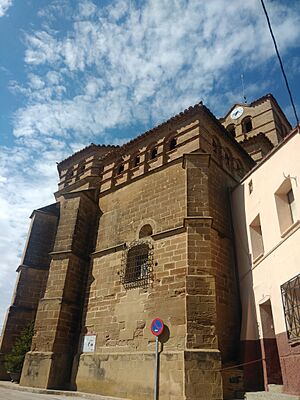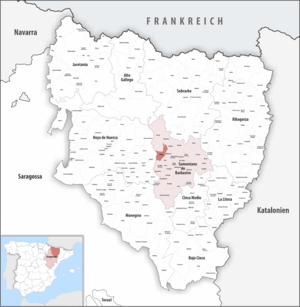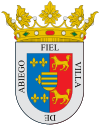Abiego facts for kids
Quick facts for kids
Abiego
|
||
|---|---|---|

The 16th century Colegiata of Santa María.
|
||
|
||

Municipal location within the Comarca of Somontano de Barbastro and Province of Huesca.
|
||
| Country | ||
| Autonomous community | Aragon | |
| Province | Huesca | |
| Comarca | Somontano de Barbastro | |
| Population
(2018)
|
||
| • Total | 237 | |
Abiego is a small and interesting municipality located in the province of Huesca, in the Aragon region of Spain. In 2018, it had a population of 237 people. This charming village is part of the Somontano de Barbastro area, known for its beautiful landscapes and rich history.
Contents
Discovering Abiego
Abiego is a quiet place where you can explore the natural beauty of the Huesca province. It is a great example of a traditional Spanish village. The area around Abiego is famous for its unique geological features. These features tell us stories about Earth's past.
Ancient Footprints in Abiego
One of the most exciting discoveries near Abiego is a collection of ancient fossil footprints. These footprints are found right where they were made, which scientists call "in-situ." You can see them along the road if you are coming from the nearby town of Bierge.
These amazing footprints date back to the late-Oligocene epoch. This was a very long time ago, about 25 million years ago! Imagine animals walking around in this area millions of years ago. Their steps left marks in the soft ground. Over time, these marks turned into fossils.
What Do Fossil Footprints Tell Us?
Fossil footprints are a special type of trace fossil. They are not the bones of an animal, but rather the marks or traces of its activity. Scientists study these footprints to learn many things:
- What animals lived there? The shape and size of the footprints can help identify the types of creatures that walked through the area.
- How big were they? The length and width of the prints give clues about the animal's size.
- How did they move? The spacing and depth of the footprints can show if the animal was walking, running, or even limping.
- What was the environment like? The type of rock the footprints are found in can tell us about the ancient landscape. Was it a muddy swamp, a sandy beach, or a dry plain?
The footprints in Abiego offer a rare glimpse into a prehistoric world. They help us understand the ancient animals and environments of this part of Spain. It's like a natural history book written in stone!
See also
 In Spanish: Abiego para niños
In Spanish: Abiego para niños



